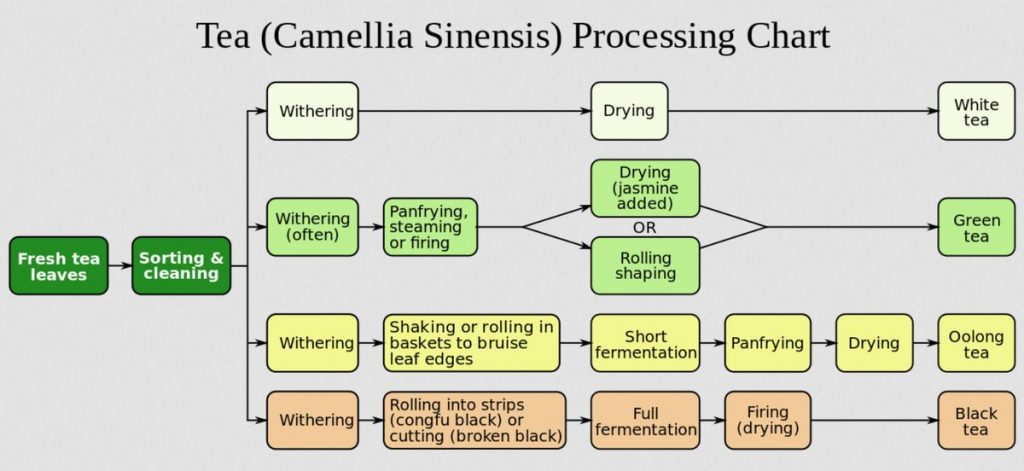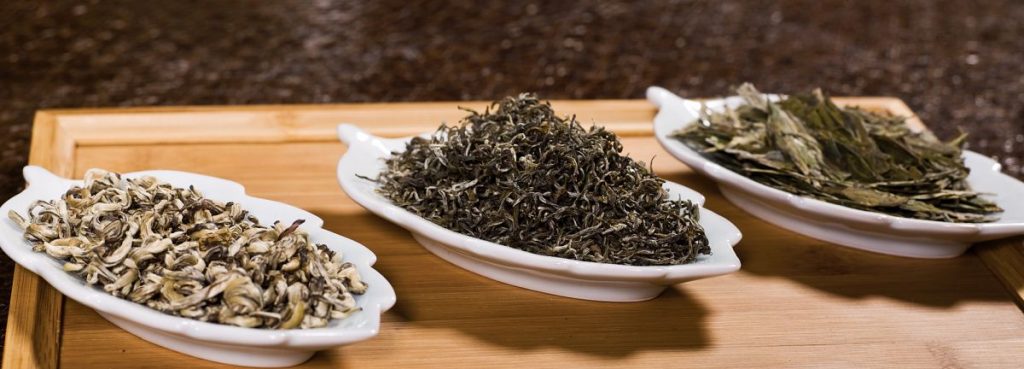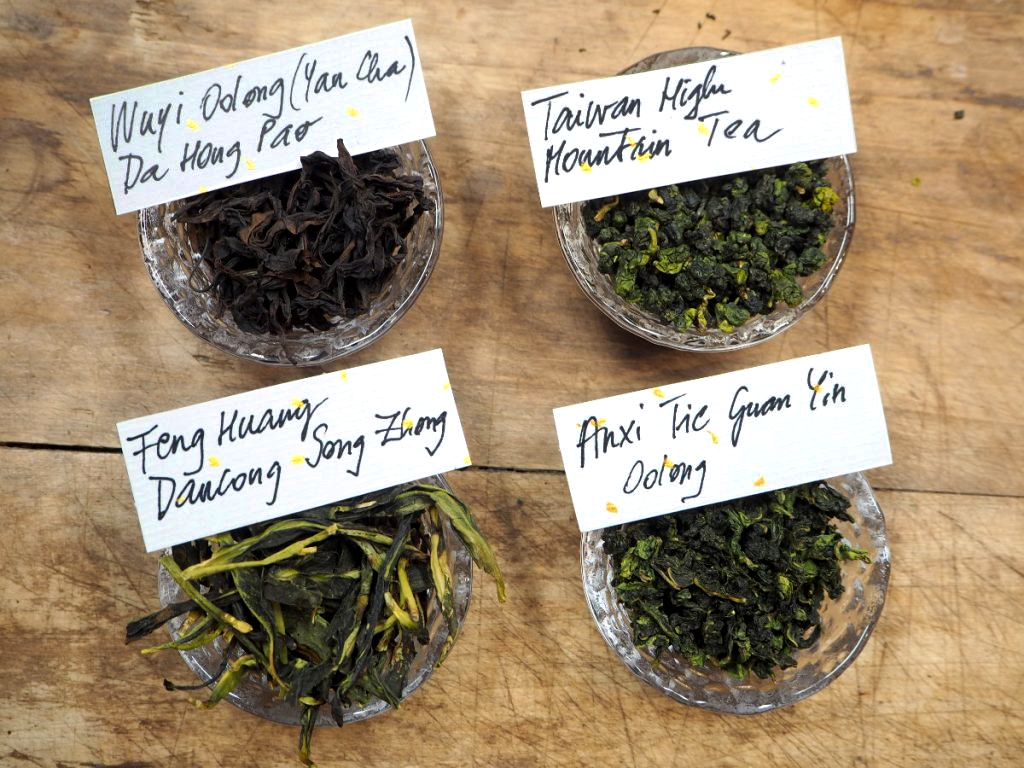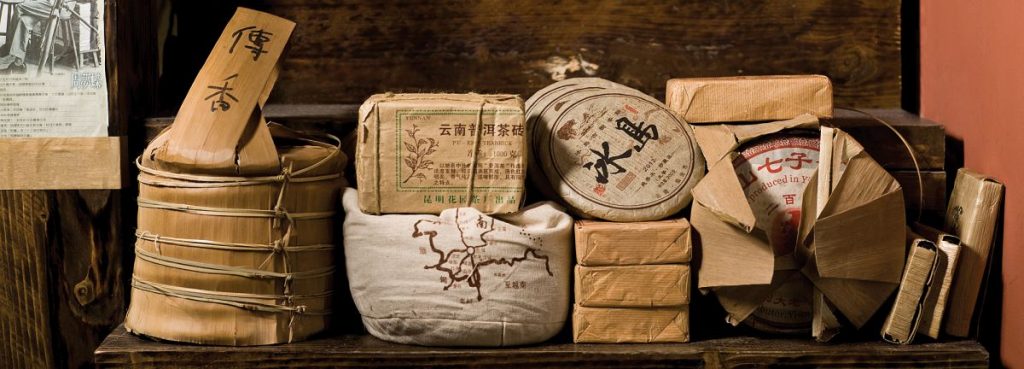6 main tea types
We primarily focus on loose-leaf tea processed from the fresh buds and shoots of Camellia Sinensis. Its health benefits have been well known both in ancient Chinese medicine and in Chinese and Japanese tea culture. They believed that tea contributed to our general mental and physical well-being, improved endurance and stamina and supported life itself. Indeed, tea’s rich antioxidants protect the cells, the L-theanine helps us relax while caffeine helps us focus. Tea also has beneficial effect on digestion. By loose-leaf tea we refer to the fresh, spring buds and shoots plucked from Camellia sinensis, an evergreen plant originating in Southwest China. The various subsequent processing methods led to the currently known types of tea: white tea, yellow tea, green tea, oolong tea, black tea, puerh tea. These are the generally accepted basic types of tea, however there exist other Chinese and Japanese tea specialties, that are well worth tasting.

The type of a tea therefore is not determined by the raw material, but by its processing method and the degree of its oxidation. Using a basket of tea leaves every type of tea can be made through the following steps.

WHITE TEA
White tea is made from the shoots, buds and fresh leaves of the plant. After plucking, the tea is left to wither in heaps then sun-dried on large trays. Finally, the batch is dried using hot air. White tea is an open-air dried sort, with freshly picked buds of younger leaves. The real secret to making white tea is to just “let it happen”: oxidation is not promoted, enzyme activity is not inhibited at all. That allows the tea to retain its fresh character while at the same time giving it a warm, sweet nature due to the minimal, natural oxidation. The infusion is fragrant, naturally sweet, slightly citrusy, smooth, and easy to drink. The simple picking and drying of white tea perfectly preserve the tea’s main constituents and active ingredients. The brew potency is low for white teas that have opened leaves.
Loose leaf white tea: White tea takes its name from the fine layer of flakes that dries on the young buds or leaves, which shine in a silvery, white color. The brew of loose white tea has a fresh fragrance, a naturally sweet, citrusy aroma, and is a particularly delicious drink. White tea is native to the subtropical climate of Fujian province. Its varieties: Bai Hao Yinzhen, Bai Mudan, Shou Mei.
Pressed white tea: Pressed white tea is a unique tea product preserved by a storage and conservation process of Fujian origin. Its wider appreciation began in 2011 in Shanghai, where a 20-year-old Lao Bai Chat was presented at a tea exhibition. Subsequently, the outstanding qualities of this old white tea sort also got noticed in Beijing, Shanghai, and Canton. An old saying refers to the aromas and physiological effects that the tea obtains during its long storage: “One year – tea, three years – medicine, seven years – treasure!”. The taste of fresh white tea becomes more oxidized, honeyed, and astringent as it matures.
GREEN TEA
Green tea is not oxidated, so the processed leaves retain much of their original green color. After plucking, the leaves are withered in heaps, then shortly heat-treated by pan-firing in a large wok (chinese green) or by steaming (japanese green). Firing „fixes” the tea by deactivating its enzymes and thus halting its natural decomposition process. The next step is shaping whereby the tea is pressed or rolled into its final characteristic shape. Finally, the leaves are dried using hot air. In the case of green tea, the oxidation and fermentation that naturally occur are stopped by a mild heat treatment after the tea gets brewed. In this case, the tea undergoes the slightest biochemical transformation possible, as it gets preserved in the initial processing stage: the state in which it got plucked from the bush. Green tea mostly originates from fresh buds harvested in the early spring, which are the most valuable part of tea bushes. The green tea brew has a natural taste, sweetish and slightly tannic. The dry tea leaves are bright green and have a significantly fresh fragrance.
Chinese and Taiwanese green tea: Chinese green teas are left to rest for a short time after picking, then lightly roasted, and shaped in various ways. Chinese green teas have a great variety and richness of form. The preparation methods and results are also very varied! The brew is usually strong, so drink carefully in the evening. The best-known varieties are Maofeng, Longjing, Bi Luo Chun.
Japanese green tea: While most Chinese green tea sorts get roasted, the Japanese-style tea processing method consists of steaming, cooling, rolling, and drying. The more thorough processing allows the tea leaves to transfer their flavors easier to the water, producing a thicker, deeper-colored infusion. The traditionally prepared Japanese green tea is remarkably dense, rich in the umami flavor, and is practically a tea essence. In the cultivation of Matcha and Gyokuro teas, shading has been used since the 16th century in the last three weeks before picking. The brew is usually strong, so only drink it carefully in the evening. Its most widely known varieties are Sencha, Gyokuro, Matcha, Hojicha, Fukamushi, Karigane.

Matcha tea: Matcha tea (抹茶), or the “greenest green tea”, is the only type of tea we consume mixed in water. In Japan, it is not only part of ceremonies but also part of everyday life. It is increasingly popular and regularly consumed in the West. When prepared in the right way, Matcha is a creamy, foamy, and vegetally sweet drink with a long aftertaste. The foam that collects on top of Matcha gets called “jade foam” because it is as vibrant as sun-dappled tea bushes on a hillside, and its density is the green of a shady forest.
YELLOW TEA
Yellow tea is very similar to green tea, that came about through an accidental error. When the leaves are left to wither for too long before the pan-firing, the tea is smothered and undergoes a light fermantation. After the extended withering, the leaves are pan-fried, shaped, then dried by hot air.
OOLONG / WULONG TEA
In the case of OOLONG TEA/WULONG TEA, following plucking and resting, the leaves are shaken in baskets, or lately in large cylinders. Through the shaking, the leaves are ruptured and bruised which allows oxidation of a larger surface. The degree of oxidation varies from mild to strong, so there are greener and redder oolong varieties. Oxidation is followed by shaping into rolled sticks or even balls. The processing if completed by light frying and hot-air drying. As a result of the varied processing, oolong teas can be very diverse in appearance and taste.
So the Oolong or Wulong tea is a semi-oxidized tea located somewhere between green and black (red) tea in terms of the degree of oxidation. During their processing, the tea leaves get shaken in baskets, with the damaged tissues allowed to oxidize slightly. In all cases, Oolong teas are recognizable for their particularly delicate, floral, intense aroma, and natural sweetness, attributable to their special location of production areas and sophisticated processing methods. Oolong teas represent the most varied and exciting part of tea culture and are a joy to drink.
Anxi Oolongs: Anxi Oolong is the lightest oxidized Oolong tea kind with a naturally sweet taste and a fresh, intensely floral scent. Anxi and its surroundings are mountainous regions located on the slopes of Mount Daiyun. The surface of the area is very stormy, with mountain ranges of 1000 and 1300 meters high winding around each other like dragons and snakes. The mountainous production area surrounded by forests has an excellent ecological environment, so the quality of the tea produced there is also excellent. The most famous Anxi Oolongs are Anxi Tie Guan Yin, Anxi Ben Shan Oolong, Anxi Huang Jin Gui, Anxi Mao Xie, Anxi Jin Guan Yin.
Taiwan High Mountain Tea: The whole island of Taiwan is a high mountain region. The cool, humid climate in the mountains slows down the development of the plant. The catechin content of the leaves decreases with a slower metabolism, but the content of amino acids, Theanine, and vitamins increases, all being responsible for sweeter flavors. Taiwan’s high-mountain Oolong teas get harvested with their buds and four of their leaves, and after processing, the whole shoot gets compressed into small dumplings that swell up enormously. The taste of high mountain Oolong teas is light, silky sweet. Their aroma reminds us of spring flowers when tasted. During processing, slight oxidation and a very restrained heat treatment give them a full-bodied and sweet decoction that hands a calm beauty to the tea drinker. Greener and baked versions are also known.

4 main types of oolong tea
BLACK OR RED TEAS
Black teas are processed similarly to oolongs, but oxidation is more complete. The entire surface of the leaf turn dark, its physical properties as well as its smell and color change drastically. Oxidation is followed by shaping then completed by hot-air drying. Although most of the best black teas come from Fujian or Yunnan, in some cases, tea can also be sourced from other provinces. Among these, special varieties with unique flavors can be discovered. Since black tea has historically had a major market worldwide, almost all provinces have used this processing method on the local shrubs.

PUERH TEA
Puerh tea is unique because in this case not only the processing method but also the plant type and the geological origin is stipulated. Puerh tea may only be made from Camellia Sinensis var. Assamica sub-type produced in Yunnan province of China. It’s important here that the pan-fried leaves are not dried any further, but are compressed into cakes, bricks or other forms and left to post-ferment. With time and fermentation, the tea matures and acquires its distinctive earthy and woody aroma and flavor. Puerh tea has a unique character and is a product made from ancient tea tree leaves originating from within the borders of Yunnan Province (southern China). After harvesting, it undergoes several years of post-ripening. As the leaves age, a genuine tea specialty with a unique composition and aroma develops. Chinese medicine considers this product a prophylactic for the lifestyle diseases that have the greatest risk factors of our time. Many call it the “old tea” as its enjoyment value and complexity have evolved over many years, and its monetary value continues to grow. It has been protected since 2006. There are two sorts of this tea kind, Sheng Puerh and Shu Puerh. Both varieties are worth fermenting for years because, in the long run, their taste only gets smoother, fuller, richer, and more complex, and their probiotic composition will get richer.
Sheng Puerh tea: Sheng tea (sheng cha) is a more ancient, naturally matured version of Puerh tea, where the roasted, kneaded, sun-dried leaves get pressed into brick- or disc-shapes and stored shortly after processing. This naturally matured tea undergoes post-ripening over the years and sees significant physical and chemical changes for over 15-20 years. Its initial green color turns into dark brown, the flavor becomes more delicate, and the brew obtains an earthy, oily aroma. Sheng tea has various traditions transcending through generations, mountains, and villages, making this tea kind unique for each of those.
Shu Puerh tea: In 1975, the Menghai Tea Factory developed an accelerated tea maturation method based on the Guangxi Liu Bao tea production technology, to meet the mass market demand. In Shu Puerh, the dried raw material is re-moistened and matured under a tarpaulin, the fermentation process takes only a few weeks, and the tea is ready for consumption. The purpose of accelerated maturation is to remove the greenish, acidic character from the tea as fast as possible and make it ready to drink. This tea is cheaper and better suited to meet the ever-growing market demand, but its aroma, texture, and aftertaste are far below the unique characteristics of traditionally aged teas.

HEICHA
Heicha is a post-ripened, fermented tea sort from various provinces in China. Heicha and Shu Puerh teas are very similar, but the significant difference is that the letter is dried and rewetted while resting in sunlight for a long time, while Heicha Tea is steeped and left to rest indoors. In the presence of oxygen, the wet tea leaves ferment and undergo a microbiological maturation process that lasts several months to many years.
This fermentation changes their chemistry, reduces their astringency, softens their flavor, and proliferates beneficial fungi and bacteria in the tea. The effects of Heicha on health and digestion are significant. Varieties: Liu Bao (Guangxi), Fuzhuan (Hunan), Liu An (Anhui), Zang Cha (Tibet), Qing Zhuan cha (Hubei), Lu Bian Cha (Sichuan).
SELECTING A TEA TYPE
When selecting tea, bear in mind that the basic character and effect of each type is slightly different. Consequently, we can best support the optimal functioning of our body with different teas in different seasons and times of the day.

